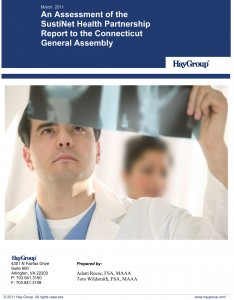SustiNet, the ambitious state plan to bring everyone with state-purchased insurance under one umbrella organization, will cost at least $62 million, according to a study funded by the state’s insurance companies.
The report, completed by Hay Group of Arlington, Virginia, uses the SustiNet board’s final report to evaluate the costs of the proposed changes, including the creation of a government-run insurance company.
The SustiNet board estimated that existing Medicaid and Husky patients would cost $45 million more under its proposal. New Medicaid patients would add $13 million and coverage for state employees and retirees would go up $19 million for a total increase of $77 million.
The SustiNet report obscured these cost increases by claiming $286 million in savings from folding State Administered General Assistance into Medicaid. The state made this change in 2010 in order to receive new federal reimbursements available under the 2010 health care reform law.
According to Hay Group, SustiNet should not get credit for the $286 million because the state is already on track to receive that money and realize the net budget benefit unrelated to anything in the currently proposed SustiNet legislation.
The SustiNet final report also claimed the state would receive $15 million in increased revenue because some residents would lose their employer-sponsored health insurance. Hay Group did not evaluate this claim.
If the SustiNet board’s estimates are correct, the state will spend $77 million more and realize $15 million in new revenue, for a net effect of adding $62 million to the deficit.
Hay Group also said the state will be open to considerable financial risk while managing an $8 billion insurance pool. “A 1 percent error in setting premiums for a program of this size could result in a loss of $80 million,” the report said.
Estimating the costs of premiums will be difficult because of the variety of populations covered, according to the report.
There are also a number of problems with SustiNet competing with private insurance companies on the health insurance exchange that will begin operating by 2014, according to Hay Group, and SustiNet may need federal waivers before it can be sold on the exchange.
For example, the state employee health plans are worth more than the “platinum” coverage level, the maximum allowed on the exchange. Only the out-of-network benefit for one of the plans equals the platinum coverage levels.
A platinum plan would have a $300 deductible and 10 percent coinsurance, while state employee plans have neither. Platinum copayments for office visits are $20, versus $10 or $15 for state employees, while prescription copayments ($15/$25/$40 vs. $5/$10/$25) also make the state employee plan exceed platinum level. State employees receive 100 percent of hospital coverage after their copayment of $0, while a platinum plan pays 90 percent after a copayment of $200.
In all, the actuarial value of the state employee health plan is 16.6 percent above the value of a platinum plan, according to Hay Group.
According to Hay Group, SustiNet will not be able to save much money through increased negotiating power or economies of scale. The state employee health plan with 200,000 members and Medicaid and Husky with 500,000 already “have the critical mass necessary to bargain effectively with providers and to establish efficient administrative systems.”
The report also casts doubt on SustiNet’s ability to find administrative efficiencies. “It does not appear that the SustiNet program eliminates any administrative functions,” the report said. “In fact, by placing different populations with very different needs under the same administrative umbrella, the administration may be made more complex.”
Hay Group also suggests that there will be winners and losers within the groups SustiNet covers because they will subsidize each other. “Because the different populations have different demographics, pooling them will likely increase premiums for some populations, while reducing premiums for others, creating implicit subsidies between the populations,” the report said.
The state could establish a Basic Health Program without SustiNet and it might be more difficult to do so within SustiNet, according to Hay Group. The BHP, part of federal health care reform, allows states to create standalone insurance pools for people just over the threshold for Medicaid. The program is funded with the subsidies its participants would have received on the insurance exchange, but affords participants with less choice than they would have on the exchange.

